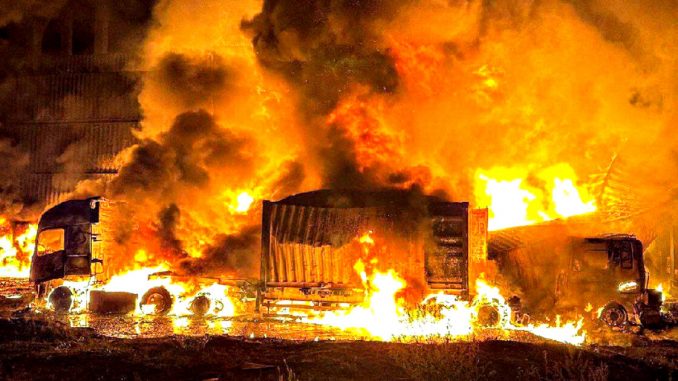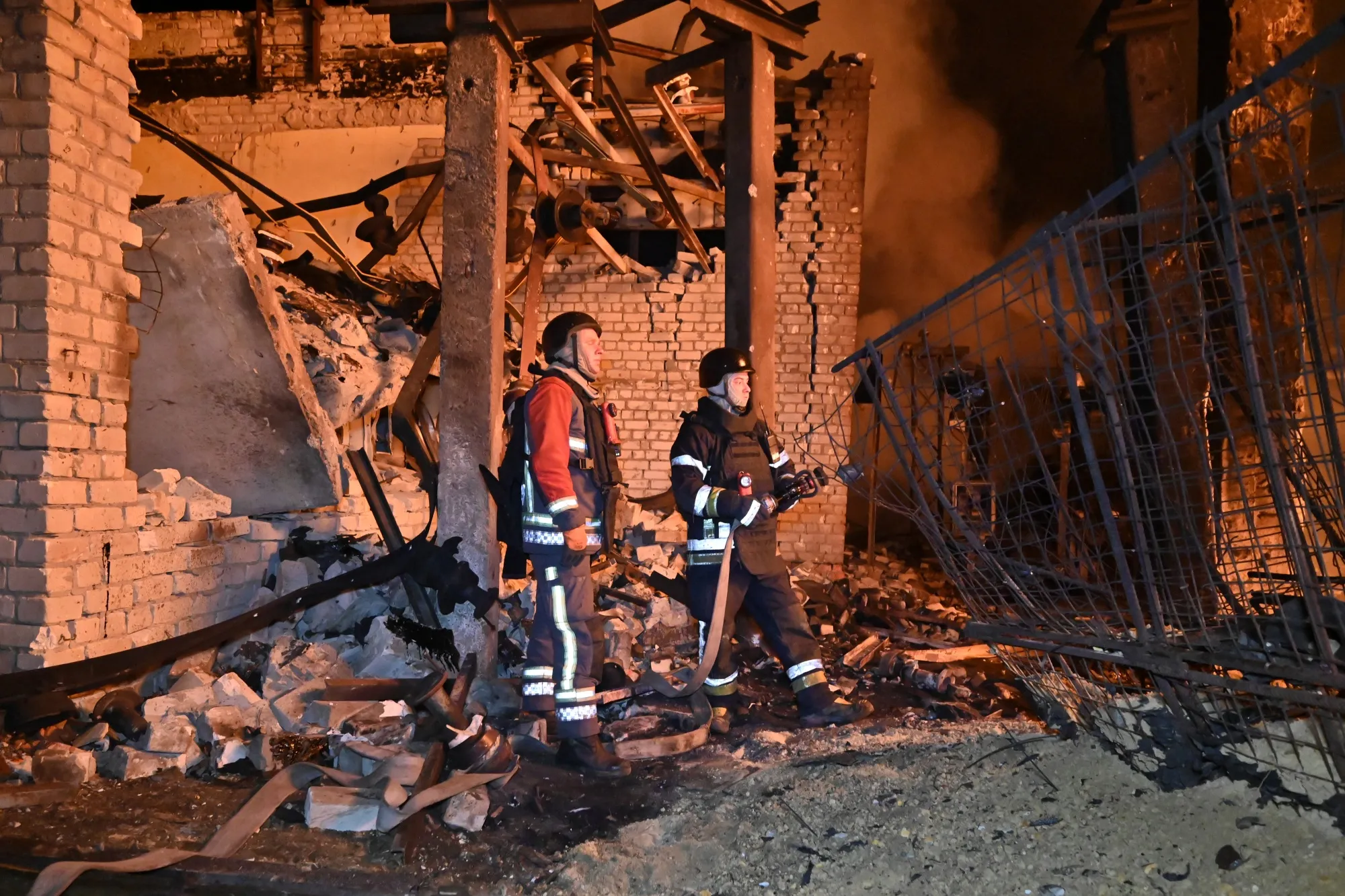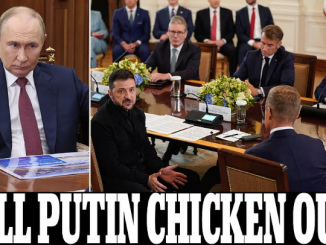
Published October 9, 2025
It will be a hard winter for Ukraine.
As Ukraine braces for another freezing winter, Russian forces have unleashed a devastating wave of drone and missile strikes that crippled the country’s energy infrastructure, reportedly knocking out more than half of its natural gas production. The strikes mark one of the most extensive attacks on Ukraine’s energy sector since the start of the full-scale invasion in 2022.
Massive Strikes on Key Energy Hubs
According to reports from Bloomberg and The Kyiv Independent, the coordinated assault occurred in early October, targeting gas fields and processing facilities across Kharkiv and Poltava oblasts. The attacks — involving more than 35 missiles and 60 drones — were described by Ukraine’s state energy company Naftogaz as the “most massive strike” on gas infrastructure to date.
Preliminary assessments indicate that up to 60 percent of Ukraine’s gas output capacity was destroyed or rendered inoperable. This figure, first reported by Bloomberg and later cited by The Kyiv Independent, underscores the scale of the damage at a time when Ukraine’s population depends heavily on domestic gas supplies for heating.
Private energy firm DTEK also halted operations at some of its key facilities in Poltava following the bombardment, signaling how deeply the attacks cut into both state and private energy production.
A Strategic Winter Offensive
The timing of the strikes suggests deliberate planning. Gas plays a crucial role in heating Ukrainian homes and powering key industries during the harsh winter months. By hitting this infrastructure in October, Russia appears to be pursuing a familiar strategy — weaponizing the cold to weaken civilian morale, drain resources, and pressure Kyiv politically and economically.
Military analysts note that such attacks are designed not only to degrade Ukraine’s ability to fight but to test public endurance and the government’s crisis management. Destroying energy sites across multiple regions forces Kyiv to disperse limited air defense and repair crews, overextending national resources already under strain.
Economic and Humanitarian Consequences
The humanitarian implications are severe. Millions of Ukrainians face the possibility of reduced heating capacity as temperatures drop, while energy prices could surge due to increased import needs.
Ukraine’s Energy Ministry is preparing to ramp up natural gas imports by roughly 30 percent, according to Bloomberg. That could cost the country over €2 billion in emergency spending through early 2026. The government has been in talks with European suppliers to secure additional volumes, but logistical challenges — from transit routes to storage limitations — complicate the process.
Repairing the damaged infrastructure will also be costly and time-consuming. Experts warn that certain facilities, such as processing plants and underground storage hubs, may take months to restore due to the precision and extent of the destruction.
Wider Strategic Impact
Beyond Ukraine’s borders, the strikes could ripple into European energy markets. While Ukraine has limited gas exports, disruptions to transit lines and domestic storage can influence regional supply and prices, particularly as Europe continues to diversify away from Russian energy sources.
Analysts also warn of possible escalation. Kyiv has already stepped up long-range drone operations targeting Russian oil refineries and energy depots, framing them as retaliatory strikes for Moscow’s attacks on civilian infrastructure. The October assault could prompt even stronger counter-measures or new Western efforts to boost Ukraine’s defensive capabilities.
An Attack on Civil Resilience
This latest strike campaign underscores that Russia’s war on Ukraine extends far beyond the battlefield. By targeting vital utilities, Moscow aims to break not just infrastructure but the endurance of ordinary citizens.
Energy, in this context, becomes a weapon — one that threatens to freeze a nation into submission. Yet Ukraine’s ability to adapt, rebuild, and maintain public resolve may ultimately determine whether the strategy succeeds.
 Public / Political Reactions
Public / Political Reactions
Ukrainian Reactions
-
President Volodymyr Zelenskyy
-
He has emphatically condemned the strikes, calling them attempts to inflict suffering on the civilian population by depriving people of gas, heat, and light.
-
He has accused the international community of showing a weak or “inadequate” response to the growing scale and audacity of Russia’s attacks.
-
Zelenskyy outlined Ukraine’s two winter plans: Plan A relying on domestic supply to the extent possible, Plan B relying on imports if damage continues.
-
He declared that Ukraine “will respond,” emphasizing that it will not simply endure the darkness or destruction.
-
-
Energy Minister Svitlana Hrynchuk
-
Announced plans to increase gas imports by ~30% to compensate for the damage.
-
Has been in discussions with G7 ambassadors about expanding import capacity and securing more support.
-
-
Naftogaz & Energy Sector Officials
-
Naftogaz CEO and others have warned publicly about the extent of damage, cost implications, and the danger to civilian life.
-
They describe the attacks as “massive” and unprecedented in scale, especially what was reported on October 3 with missile and drone waves.
-
Foreign / International Reactions
-
Allies / Western Governments
-
Ukraine is appealing to G7 and other Western partners for financial aid, technical support (especially air defence), and infrastructure repair.
-
There are talks of increasing LNG imports, or diversifying suppliers, to reduce dependency and fill in the gap of lost domestic production.
-
-
European Union
-
It is implied in some reporting that EU institutions are watching closely and have been part of the discussions with Ukraine over aid and energy security. (Though specific public statements may be more limited in the sources I found.)
-
-
International Observation / Criticism
-
Ukraine has characterized the strikes as targeting civilian infrastructure, which many international observers view as violating the laws of war. Zelensky’s rhetoric emphasizes that these are deliberate attacks aimed at civilian suffering.
-
There is growing concern among human rights groups, NGOs, and UN-related agencies about the humanitarian implications of loss of energy, heat, gas. (Though in the current set of reports, I didn’t find a detailed UN statement specifically about this particular strike wave beyond what was previously reported in similar contexts.)
-
-
Russia’s Position
-
Russian official statements generally deny targeting civilians or non-military infrastructure, or claim that such strikes are in response to Ukrainian actions. (This is consistent with past patterns though specific source quotes in relation to this latest strike wave were less detailed in the sources I checked.)
-
Political Implications & Pressure
-
There is increasing domestic pressure on the Ukrainian government to ensure that citizens are protected from energy shortages, heating failures etc., particularly with winter coming. The loss of >50% of gas production raises stakes in public welfare.
-
Internationally, it creates urgency for more robust aid packages, infrastructure hardening, and perhaps stronger sanctions or diplomatic measures against Russia, as well as more support for Ukraine’s air defence and energy import capacity.
-
The political narrative is that this is not just a military front, but a “home front” struggle, as Zelenskyy frames it: protecting civilians from darkness, cold, and deprivation is part of Ukraine’s resistance.
 Resulting Effects
Resulting Effects
The aftermath of Russia’s strikes on Ukraine’s gas infrastructure is already reshaping both the nation’s internal stability and its broader economic landscape. The destruction of over half of Ukraine’s gas output has triggered a chain of operational, social, and geopolitical consequences that are likely to intensify as winter sets in.
1. Domestic Energy Crisis and Civilian Hardship
Millions of Ukrainians face the risk of heating shortages during the coldest months of the year. Gas remains the primary source of household heating, particularly in northern and eastern regions. With local production crippled, Ukraine must rely heavily on imported gas — much of it transported through fragile European supply routes.
Households could experience rolling blackouts, limited heating hours, or soaring energy bills as demand rises and supplies shrink. Vulnerable populations — including the elderly and displaced families — stand to suffer the most. Aid groups have already begun warning of potential humanitarian emergencies in urban centers if energy deficits persist into late winter.
2. Economic Strain and Budget Reallocation
Ukraine’s economy, already weakened by prolonged war, faces additional financial pressure. The government is diverting billions from defense and social welfare programs to cover emergency energy imports and infrastructure repairs.
Energy imports are projected to cost around €2 billion over the coming months, adding to an already record-high fiscal deficit. This redirection of funds could delay reconstruction projects and restrict the government’s ability to fund local administrations or maintain subsidies for low-income families.
Furthermore, the damage to industrial gas supplies will directly affect manufacturing and agriculture, both of which depend on consistent energy access. Factory downtimes and reduced production could drag GDP growth forecasts lower for the first quarter of 2026.
3. Increased Dependence on Western Aid
The energy shortfall is forcing Kyiv to turn more urgently toward Western allies for technical, financial, and logistical support. This includes not only emergency gas imports but also requests for advanced air defense systems to prevent further strikes on critical infrastructure.
The situation strengthens Ukraine’s diplomatic case for continued Western backing but also deepens its dependency. As energy vulnerability grows, so does Kyiv’s reliance on international donors to keep essential services running — a dynamic that Russia may be exploiting strategically.
4. Escalation and Retaliation Risks
The strikes could mark a new escalation phase in the war’s “infrastructure front.” Ukraine has already intensified drone attacks on Russian oil and gas facilities, signaling that Kyiv may respond in kind. Such tit-for-tat targeting risks widening the scope of the conflict and affecting global energy markets if critical Russian exports are hit.
Both sides now view energy as a battlefield — one that can shape morale, logistics, and economic endurance as much as traditional combat.
5. Long-Term Infrastructure Vulnerability
Ukraine’s gas network — once a robust Soviet-era system — now faces cumulative degradation. Repeated missile strikes have exposed how outdated and defenseless much of its infrastructure remains. Repairing and modernizing facilities will take years and require billions in foreign investment.
The government has begun exploring partnerships for decentralized and fortified energy solutions, including modular gas units and renewable alternatives. However, these projects cannot replace the vast capacity lost overnight in October’s assault.
6. Regional Energy Security Ripple
The crisis also reverberates across Eastern Europe. Ukraine’s energy network connects to several EU markets, and disruptions there can tighten supplies or increase prices regionally. While the EU is less dependent on Ukrainian gas transit than before, any further damage to cross-border infrastructure could raise import costs and complicate storage planning for winter 2025–2026.
Watch: Karkhov goes dark:
“’Russia will do everything to prevent us from extracting our gas’, Ukrainian President Volodymyr Zelenskiy told reporters in Kyiv on Monday. ‘They will do everything. It will be difficult to protect all this. The task is to have money to import gas so that people have gas’.”

Emergency services attend the site of a Russian attack on energy infrastructure in Kharkiv, on Oct. 7.Photographer: Sergey Bobok/AFP/Getty Images
 Future Outlook
Future Outlook
As winter approaches, Ukraine stands at a critical juncture. The recent wave of strikes on its gas infrastructure has forced the government, its allies, and energy experts to rethink not only immediate survival strategies but also the country’s long-term energy security. The coming months will test Ukraine’s capacity to adapt, improvise, and rebuild under sustained pressure.
1. Short-Term Survival: Import, Repair, and Conserve
In the immediate term, Ukraine’s focus will remain on stabilizing gas supply before temperatures plunge.
-
The Energy Ministry plans to increase gas imports by up to 30 percent, sourcing from European partners and tapping underground reserves.
-
Emergency repair brigades are working around the clock to restore partial functionality to damaged gas compression and storage facilities.
-
Authorities are preparing energy-saving measures, such as limiting non-essential industrial usage and implementing controlled heating schedules in major cities.
However, these steps are stopgap solutions. Ukraine’s domestic energy resilience remains fragile, particularly if new waves of Russian strikes continue targeting key nodes in the grid.
2. Strengthening Air Defense and Infrastructure Hardening
Kyiv’s military planners now consider the protection of energy facilities a national security priority. Western partners, including the United States, the United Kingdom, and several EU states, are reportedly discussing the deployment of additional air defense systems—specifically Patriot and NASAMS batteries—to shield energy-rich regions like Poltava and Kharkiv.
Parallel to defense efforts, Ukraine is exploring infrastructure hardening strategies, such as:
-
Relocating critical gas compression equipment underground.
-
Building redundant networks that can reroute gas flow when facilities are damaged.
-
Expanding the use of mobile gas-processing units that can be moved or hidden during attacks.
These innovations may not prevent every strike, but they could reduce recovery time and limit the impact of future bombardments.
3. Accelerated Transition Toward Renewable Energy
The war is accelerating a strategic energy transformation. With gas fields repeatedly targeted, Ukrainian policymakers are revisiting national plans for solar, wind, and biogas projects. Western energy firms have shown interest in financing decentralized renewable hubs—safer from large-scale strikes and easier to rebuild.
While renewables cannot fully replace natural gas in the near term, they may serve as a resilience buffer, ensuring at least partial independence from both Russian attacks and volatile gas markets.
4. Western Support and Regional Cooperation
The crisis could strengthen Ukraine’s case for expanded Western aid, particularly in energy reconstruction. The European Union is already reviewing new assistance programs under its Ukraine Facility 2025–2027, which could include funding for modern energy storage, cross-border interconnections, and fortified heating systems.
At the same time, regional partners like Poland, Slovakia, and Romania are preparing to facilitate increased gas transit and share reserve capacities with Ukraine. Such cooperation could evolve into a regional energy alliance designed to withstand Russian hybrid warfare.
5. Russia’s Continuing Pressure Campaign
Strategically, Moscow is expected to continue using infrastructure warfare as a means of psychological and political pressure. By repeatedly striking power plants, refineries, and gas facilities, Russia aims to sap Western resolve and force Kyiv into costly cycles of repair and dependency.
However, this tactic carries diminishing returns. Each new assault invites stronger international condemnation, tighter sanctions, and more robust defense commitments to Ukraine. In time, these consequences could erode Russia’s leverage and further isolate its economy.
6. Long-Term Outlook: A Rebuilt but Reinvented Energy Network
Even after the war, Ukraine’s energy system will not return to its pre-2022 form. Reconstruction plans under development envision a modernized, decentralized, and NATO-standardized grid, integrated more closely with Europe’s energy market.
In this future, Ukraine could emerge as a regional energy hub, leveraging its vast storage capacity and renewable potential — turning wartime destruction into the foundation for a more resilient and self-sufficient energy system.
 Bottom Line:
Bottom Line:
Russia’s latest strike campaign against Ukraine’s gas infrastructure underscores a brutal truth about modern warfare — that energy has become both a weapon and a battlefield. By crippling more than half of Ukraine’s natural gas production, Moscow has once again shifted the conflict’s front line from trenches and skies to power plants and pipelines.
For Ukraine, the devastation is severe, but not paralyzing. Repair crews continue to work through the night, rebuilding what can be salvaged. Government ministries are negotiating urgent energy imports, while air defense forces brace for the next wave of attacks. Ordinary citizens — who have endured years of hardship — are once again preparing to face winter with limited heat but unwavering resolve.
The strikes have inflicted deep wounds on Ukraine’s economy and infrastructure, yet they have also galvanized international support and accelerated the country’s transition toward a more secure, diversified energy system. Every attack, in turn, exposes the moral and strategic bankruptcy of using civilian suffering as a weapon of war.
As Ukraine confronts the freezing months ahead, its resilience will be measured not only by how much energy it can restore, but by the spirit of its people — a nation refusing to be broken, even when its lights go out.
SOURCES: THE GATEWAY PUNDIT – Russian Drone and Missile Strikes Knock Out 60 Percent of Ukraine Gas Production – Country Is Vulnerable Ahead of Winter (VIDEO)
BLOOMBERG – Russian Strikes Knock Out More than Half of Ukraine Gas Production Ahead of Winter
THE KYIV INDEPENDENT – Russian strikes reportedly destroy over half of Ukraine’s gas output before winter





Be the first to comment